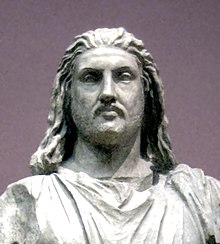Mausolus
| Mausolus | |
|---|---|
 Mausolus, 377–353 BC. Casting from the Pushkin museum. | |
| Satrap of Caria | |
| Reign | 377–353 BC |
| Predecessor | Hecatomnus |
| Successor | Artemisia II |
| Consort | Artemisia II |
| House | Hecatomnids |
| Father | Hecatomnus |

Mausolus (Greek: Μαύσωλος or Μαύσσωλλος[1], Carian: [𐊪𐊠]𐊲𐊸𐊫𐊦 Mauśoλ “much blessed”[2][3]) was a ruler of Caria (377–353 BC), nominally a satrap of the Achaemenid Empire. He enjoyed the status of king or dynast by virtue of the powerful position created by his father Hecatomnus (Carian: 𐊴𐊭𐊪𐊳𐊫 K̂tmño) who had succeeded the assassinated Persian Satrap Tissaphernes in the Carian satrapy and founded the hereditary dynasty of the Hecatomnids. He is best known for the monumental shrine, the Mausoleum at Halicarnassus, erected and named for him by order of his widow (who was also his sister) Artemisia.
Biography[edit]
Mausolus was the eldest son of Hecatomnus, a native Carian who became the satrap of Caria when Tissaphernes died, around 395 BC.
Mausolus participated in the Revolt of the Satraps, both on his nominal sovereign Artaxerxes Mnemon's side and (briefly) against him. In 366 BC, Mausolus together with Autophradates of Lydia, at the request of Artaxerxes, led the siege of Adramyttium against Ariobarzanes, one of the members of the Great Satraps' Revolt, until Agesilaus, king of Sparta, negotiated the besiegers' retreat.[4]
Mausolus conquered a great part of Lycia circa 360 BC, putting an end to the line of dynasts that had ruled there. He also invaded Ionia and several Greek islands; and he cooperated with the Rhodians in the Social War against Athens. He moved his capital from Mylasa, the ancient seat of the Carian kings, to Halicarnassus.
Mausolus embraced Hellenic culture. He is best known for the monumental shrine, the Mausoleum at Halicarnassus, erected and named for him by order of his widow (who was also his sister) Artemisia. Antipater of Sidon listed the Mausoleum as one of the Seven Wonders of the Ancient World. The architects Satyrus and Pythis, and the sculptors Scopas of Paros, Leochares, Bryaxis and Timotheus, finished the work after the death of Artemisia, some of them working (it was said) purely for renown. The site and a few remains can still be seen in the Turkish town of Bodrum. Derived from his name, the term mausoleum has come to be used generically for any grand tomb.
An inscription discovered at Milas, the ancient Mylasa,[5] details the punishment of certain conspirators who had made an attempt upon his life at a festival in a temple at Labraunda in 353 BC.
Literature[edit]
| Hecatomnid dynasty (Dynasts of Caria) | ||||||||||||||||
|---|---|---|---|---|---|---|---|---|---|---|---|---|---|---|---|---|
|
||||||||||||||||
- Simon Hornblower: Mausolus, Clarendon Press, Oxford 1982
References[edit]
- ^ CNG: SATRAPS of CARIA. Maussolos. Circa 377/6–353/2 BC. AR Tetradrachm (23mm, 15.13 g, 12h). Halikarnassos mint. Struck circa 370–360 BC.
- ^ Lajara, Ignacio-Javier Adiego (2007). The Carian Language. BRILL. p. 330. ISBN 978-90-04-15281-6.
- ^ Melchert, H. Craig. "Naming Practices in Second- and First-Millennium Western Anatolia" (PDF).
- ^ Gershevitch 1985, p. 378
- ^ CIG. Philipp August Böckh. p. ii 2691 c.
External links[edit]
| Wikimedia Commons has media related to Mausolus. |
- Livius, Mausolus by Jona Lendering
- Caria
 This article incorporates text from a publication now in the public domain: Chisholm, Hugh, ed. (1911). "Mausolus". Encyclopædia Britannica. 17 (11th ed.). Cambridge University Press. p. 917.
This article incorporates text from a publication now in the public domain: Chisholm, Hugh, ed. (1911). "Mausolus". Encyclopædia Britannica. 17 (11th ed.). Cambridge University Press. p. 917.


